How to properly prepare basil for the winter at home in different ways
Dried, frozen, canned in vinegar or olive oil, basil will be very useful in winter. The blanks retain the taste, aroma and vitamin and mineral composition of fresh herbs. Aromatic soothing tea is prepared from the flowers, the leaves are put into soups, pasta, vegetables, turkey or chicken meat. Greens are used as the main ingredient in the famous Italian pesto sauce.
You will find out how to prepare basil for the winter by drying, freezing and canning.
The content of the article
Basil varieties for winter preparations
Basil is conventionally divided into two varieties - purple and green. Varieties with green leaves are characterized by a delicate taste and pleasant aroma, purple ones are endowed with specific taste qualities.
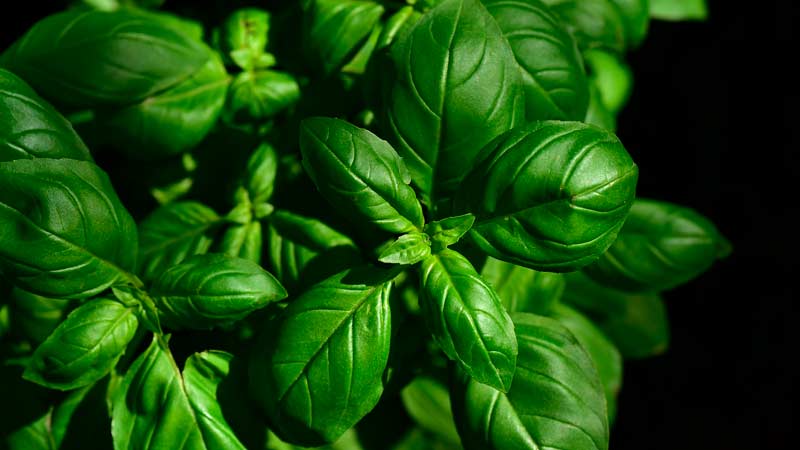 Varieties are divided according to taste and aroma. Some are ideal for making confectionery, others are put in soft drinks and alcoholic drinks, and others are added to soups and hot dishes.
Varieties are divided according to taste and aroma. Some are ideal for making confectionery, others are put in soft drinks and alcoholic drinks, and others are added to soups and hot dishes.
What flavors are rich in basil varieties:
- peppery taste and aroma have varieties Rosie, Basil broadleaf, Edwina, Camphor, Aramis, Ruby, Magic of the East, Thai Queen, Baku, Ararat;
- Clove Scent - Dark Night, Clove, Tulasi, Clove Scent, Sandwich Leaf;
- anise smell - Anise delight, Wonderful day, Anise basil, Italian Basil;
- pepper-clove smell - Basilisk, Marquis;
- aroma of menthol and lemon - Spark, Velvet, New, Lemon, Lemon;
- vanilla flavor - Vanilla flavor;
- caramel aroma - caramel basil;
- cinnamon smell - Vegetable basil;
- peppermint - Greek.
By the name it is easy to determine which of the varieties is best for a particular dish:
- with lemon, vanilla, caramel, cinnamon aromas - for confectionery, baked goods;
- with aniseed, menthol, lemon, mint scent - for drinks;
- with clove and pepper smell - for meat dishes.
Any of the varieties can be harvested for the winter by freezing, drying, salting, canning in oil, vinegar.
In the photo - green and purple basil.
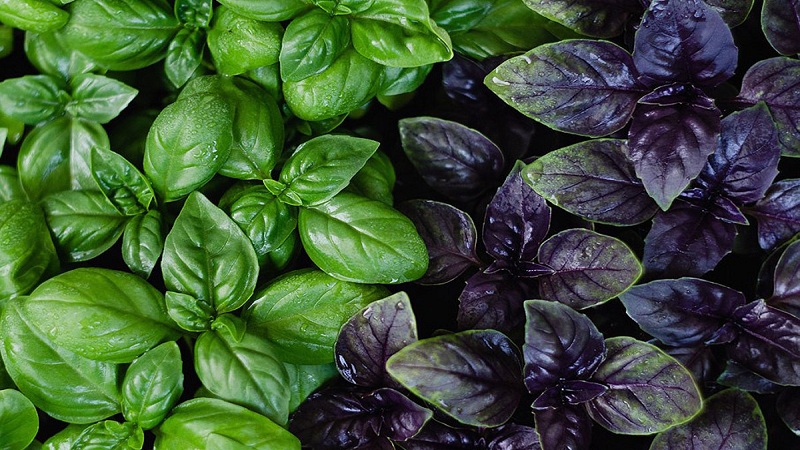
Selection and preparation
Scented greens are abundant in markets and supermarkets. It is grown without any problems in the country. In the evening, the bushes are watered, and in the morning they are collected: with sharp scissors, juicy young twigs without flowers are cut off. During the night, the leaves absorb all the moisture, acquire elasticity and juiciness. Such greens are used for freezing.
Collect basil for drying during the day without pre-watering. Bushes come easily out of dry ground. The collected branches are examined, dry and diseased leaves are cut off. For blanks, use whole branches or only leaves and flowers.
Greens are washed under the tap, thoroughly washing away dirt, dust, insects. Then dry between two layers of paper or waffle towels or in a lettuce dryer.
Reference. In Italy, basil was considered a symbol of love, and in Romania, a basil branch taken by a young man from a girl's hands meant consent to marriage. In Mexico, there is a belief that the plant protects a married couple from betrayal.
How to dry basil
How is dried basil harvested at home? This is not difficult. Drying allows you to preserve the taste and useful properties of greens.It is dried in an oven, outdoors or in an electric dryer.
On air
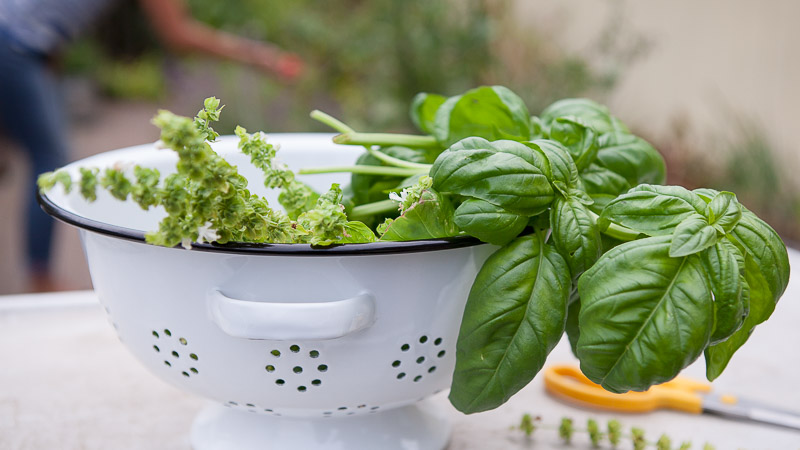
A natural way of drying, which makes it possible to preserve the vitamin and mineral composition and smell of the plant to the maximum. The seasoning is used in soups and side dishes of pasta, potatoes, eggplant and zucchini. It is recommended to add dried herbs to hot dishes to fully reveal their flavor.
There are two ways to naturally dry:
- Leaves (whole or crushed) are spread on a baking sheet or board covered with parchment and left in a warm and dry room or placed on a balcony in partial shade, covered with gauze from flies.
- The branches are tied in bunches and hung in a well-ventilated room. It is important to monitor the humidity of the air - with increased branches, they will begin to rot from the middle of the beam.
Under these conditions, basil dries up in 1-3 days.
In the oven
Drying in the oven is the fastest way. However, there is a risk of drying the greens to a state of dust, and the plant loses most of its nutrients.
The baking sheet is covered with parchment and the leaves or branches are laid out in one layer. Drying temperature - + 40 ... + 50 ° C. Drying time with the door ajar is 40-60 minutes.
If the functionality of the oven does not allow keeping the door open, the temperature is set at + 30 ° C. The oven is opened for airing every 15-20 minutes.
In an electric dryer
Modern models of electric dryers maximally preserve the beneficial properties of herbs, vegetables and fruits. Only leaves are spread on pallets for even drying.
Heating temperature - no more than + 40 ° C, time - no more than 1 hour. A timer and a transparent cover make it possible to turn off the device on time.
It is interesting:
Is it possible to freeze horseradish for the winter and how to do it right.
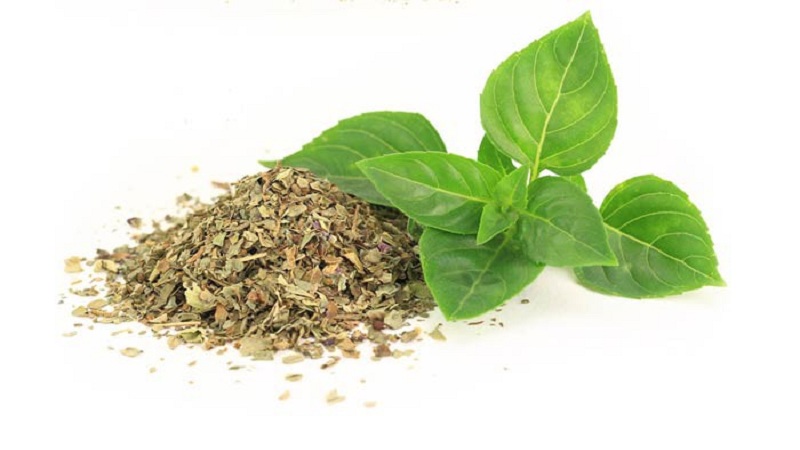
Can flowers be dried
There are two opposite opinions about the timing of harvesting the plant for subsequent drying. Some argue that the collection must be carried out before flowering, others - when the first flowers appear. Both in the first and in the second case, there is only one argument: the plant contains more vitamins and aromatic substances.
Basil flowers are most commonly used in folk medicine to brew a soothing tea. For 250 ml of boiling water, take 4 tbsp. l. dried leaves and flowers.
There is no need to specially remove flowers for drying. They are left on the branches and dried naturally.
Freezing rules
Freezing is considered the best way to preserve the beneficial properties of a product, provided that the rules are followed. Packaging for storing greens should be air and moisture resistant, strong, easy to open and close.
Zip lock bags and containers with airtight lids are ideal.
Fresh
Whole or chopped leaves are placed in a container and placed in the freezer. The second method involves freezing bunched branches. They are placed in a bag or wrapped in cling film.
Blanched
Blanching kills bacteria and fungi, preserves the color, taste and structure of leaves, removes excess bitterness.
At the same time, you will need to prepare two containers - with boiling water and ice water. The water is brought to a boil, the basil is placed on a fine mesh or in a colander and dipped in boiling water for 5 seconds. Then taken out and placed in ice water. Greens are dried on paper or waffle towels, and then folded into a container for freezing.
In olive oil

Blanched basil is chopped in a blender or chopped with a sharp knife, poured with olive oil in an arbitrary proportion, mixed and laid out in ice molds. The frozen cubes are removed and placed in a bag or tray with a lid.
You can do it differently: put chopped basil in molds, pour olive oil on top.
Reference. When frozen, olive oil does not lose its beneficial properties, since oxidation does not occur on contact with air.
Puree
Branches and leaves are placed in a blender bowl, 2-3 tablespoons of pure water are poured in, chopped into puree. The mass is poured into molds for ice, muffins or sweets and placed in the freezer.
Instead of water, you can add vegetable broth, green tea, any vegetable oil or juice.
Preservation methods: the best recipes
Salted basil is preserved in the same way as sorrel, dill, parsley, or celery.
The leaves are blanched, covered with salt to taste, tamped into sterilized 250 or 500 ml jars until the juice is released. The container is placed in a saucepan, sterilized for 15-20 minutes and sealed with lids.
With sugar and vinegar
Pickled basil is added to first courses, salads, snacks, pasta.
To prepare the blank you will need:
- basil - 500 g;
- salt - 50 g;
- vinegar - 50 ml;
- sugar - 70 g
The leaves are crushed in a blender or finely chopped with a sharp knife, mixed with salt, sugar and vinegar. The mass is transferred to clean jars and put to pasteurize in a water bath for 15 minutes. The blanks are sealed with lids, cooled under a blanket and stored in the pantry.
With olive oil
To prepare canned pasta, you need only three products:
- basil - 500 g;
- olive oil - 200 ml;
- salt - 80 g.
The greens are placed in a blender bowl, crushed to a puree state, oil and salt are added. The mass is mixed, laid out in jars with a volume of 200-250 ml, covered with lids and placed on the lower shelf of the refrigerator. Puree can be pasteurized in a water bath for 20 minutes, corked and stored in a cellar or pantry.
With garlic, or the classic pesto sauce
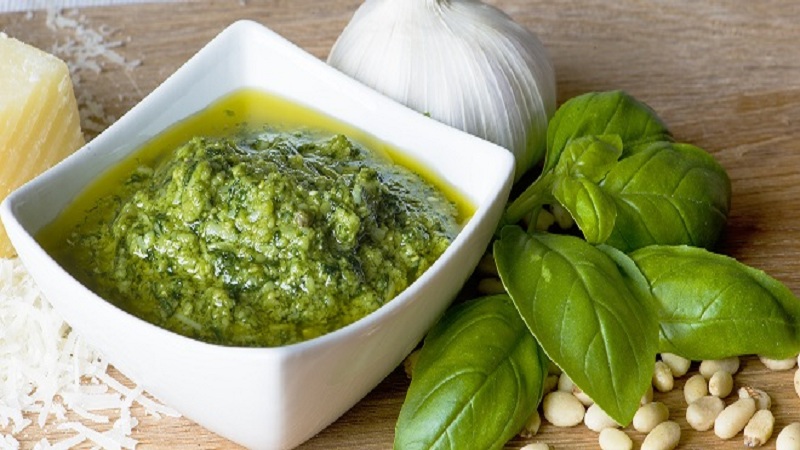
This is a delicious seasoning for pasta, potatoes, rice, vegetables and meat. To prepare it you will need:
- basil - 400 g;
- garlic - 4 cloves;
- parmesan - 200 g;
- pine nuts - 50 g;
- salt to taste;
- Extra Virgin olive oil - 500 ml.
The leaves are washed and dried on a paper towel. Nuts are calcined in a frying pan until golden brown and pounded hot in a mortar or blender with garlic. Add basil and gradually rub it into the mass. Then add grated parmesan and olive oil, salt to taste.
Pesto is placed in jars or food containers, oil is poured on top and sealed. The sauce is stored in the freezer or refrigerator.
Read also:
Features of pickling cucumbers for the winter in a barrel.
How to prepare carrot caviar for the winter: a selection of the best recipes.
Dressing with nuts
A savory dressing is prepared based on basil leaves, garlic and any nuts.
Ingredients:
- nuts (walnuts, cashews, pistachios, almonds, pecans) - 50 g;
- basil - 300 g;
- olive or any other vegetable oil - 250 ml;
- salt to taste;
- garlic - 3 cloves.
The nuts are ground in a blender into flour, herbs, garlic, oil are added, whipped into a homogeneous mass, and salted to taste. The mass is laid out in a container and stored in a refrigerator or freezer.
Storage terms and rules
The optimal shelf life of blanks from any greenery is six months. Then the plant retains its smell, taste and beneficial properties. Basil is harvested every season.
Storage periods depending on the processing method:
- blanched - 6-12 months;
- canned (pasteurized) - 1-2 years;
- canned without sterilization - 6 months;
- dried - 2 years;
- frozen at –18 ° C - 1 year.
After opening, the jar is stored in the refrigerator for 2-4 days.
Dried herbs are stored in kraft bags, glass jars, or clay spice containers in a dry, cool and dark place.
Conclusion
Drying or freezing basil, salt, canning with vinegar or oil for the winter is the choice of every housewife. Any of these methods preserves the nutritional value of the product, its aroma and taste. Dried herbs are added to hot dishes for better flavor and aroma release.
Whole frozen leaves are useful for preparing salads and decorating dishes. Spaghetti and salads are seasoned with sauce and pasta with nuts and olive oil, added to meat and vegetables.